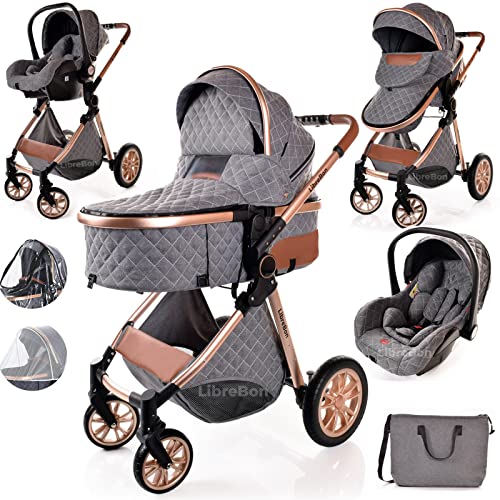Prams and Pushchairs: A Comprehensive Guide for New Parents
Browsing the world of baby transportation can be overwhelming for new moms and dads, specifically when it comes to selecting between prams and pushchairs. Each option offers distinct advantages and restrictions, suggesting that making an informed decision is essential. Prams Pushchairs aims to supply a thorough understanding of prams and pushchairs, their distinctions, functions to consider, and ideas for selecting the ideal one.
Understanding the Basics: Prams vs. Pushchairs
Prams and pushchairs are terms often used interchangeably, however they refer to various types of baby transport systems.
Definitions:
- Prams: Traditionally developed for newborns and babies, prams have a big, fully flat bassinet that allows for ideal comfort and security throughout early phases of a child's life.
- Pushchairs: Designed for older babies and young children, pushchairs normally have an upright seat that appropriates for children who can support their head and neck. They typically include adjustable recline alternatives.
Secret Differences
| Function | Pram | Pushchair |
|---|---|---|
| Style | Flat bassinet | Upright seat |
| Age Suitability | Newborn to around 6 months | 6 months to 4 years |
| Portability | Generally heavier, less foldable | Typically light-weight and foldable |
| Convenience | Cozy for newborns, tight fit | Adjustable, can be reclined |
| Usage | Ideal for walks and leisure | Versatile for daily activities and travel |
Functions to Consider When Choosing Prams and Pushchairs
Security Features
- Harness systems (5-point vs. 3-point)
- Braking systems (foot-operated vs. hand-operated)
- Stability and toughness of the frame
Weight and Portability
- Think about the weight of the pram or pushchair
- Try to find a model that folds quickly for transport
Size and Storage
- Inspect dimensions for fitting through doorways and in car trunks
- Look for additional storage alternatives like baskets or pockets
Convenience
- Padded seats and adjustable recline positions
- Suspension systems for smoother trips on rough terrains
Weather condition Protection
- UV defense in sunshades
- Alternatives for rain covers and windshields
Wheels and Maneuverability
- Wheel size and type (fixed vs. swivel)
- Suspension systems that aid handling and convenience
Durability
- Designs that transform from pram to pushchair
- Sturdier frames that can accommodate growing children
Popular Types of Prams and Pushchairs
When considering prams and pushchairs, moms and dads frequently discover numerous styles accommodating specific needs. Here are some widely known types:
1. Requirement Prams/Pushchairs
These are great all-rounders, designed for everyday use with a durable frame and adequate storage area. They are typically adjustable and can handle numerous terrains.
2. Travel Systems
These include a car seat and a stroller that can be used together, making it easy to transfer the baby from the cars and truck to the pram without waking them up.
3. Umbrella Strollers
These are light-weight and foldable, best for quick outings and travel. While hassle-free, they frequently do not have a few of the security and convenience functions discovered in heavier designs.
4. All-Terrain Strollers
Created for off-road experiences, these strollers have larger wheels and a more rugged frame, making them ideal for active households.
Picking the Right Pram or Pushchair
When choosing the ideal pram or pushchair, parents need to take the following steps:
- Assess Lifestyle Needs: Consider how you will utilize the pram or pushchair (everyday strolls, travel, uneven terrain) and pick appropriately.
- Test Drive: It's helpful to physically evaluate the designs at the shop, looking for handling, convenience, and weight.
- Research study Brands: Look at reviews and suggestions from other moms and dads about specific brands or models.
- Think About Future Needs: Think ahead to guarantee the choice will work as the child grows. Convertible designs provide flexibility.
- Budget plan: Set a budget plan but also consider quality and longevity. Sometimes investing more at first can save costs in the long run.
Regularly Asked Questions
What is the best age to begin utilizing a pushchair?
The majority of pushchairs can be used for babies from about 6 months old when they can adequately support their heads and necks. Make sure to check the producer's specs.
Are prams ideal for newborns?
Yes, prams are ideally matched for newborns due to their flat bassinet style, offering a comfy and secure environment.
How do I clean a pram or pushchair?
Constantly describe the producer's guidelines, but a lot of covers are detachable and can be washed. Wipe down the frame with a wet cloth and avoid utilizing severe chemicals.
Can I use a pram or pushchair on public transport?
Various models differ in size; lightweight and foldable choices are generally better for buses or trains. However, constantly look for transportation guidelines in your location.
How long can I utilize a pram or pushchair?
It typically depends upon the weight limit defined by the maker, typically in between 15-50 lbs, or until your kid no longer wishes to be pushed.
Selecting in between a pram and a pushchair is a substantial decision that caters to the way of life and needs of both the parent and the kid. By understanding the distinctions between the 2, assessing critical functions, and choosing the best design, parents can ensure they have a safe, comfy, and practical transportation solution for their children.
Arming oneself with understanding supplies parents not just comfort however also the self-confidence to make the best choice for their child's early experience into the world. Various way of lives demand various options, so putting in the time to research study and test what fits can alleviate some of the tensions that feature new being a parent. Delighted strolling!

